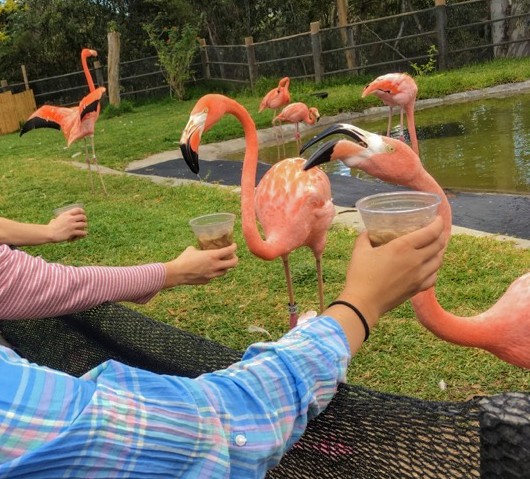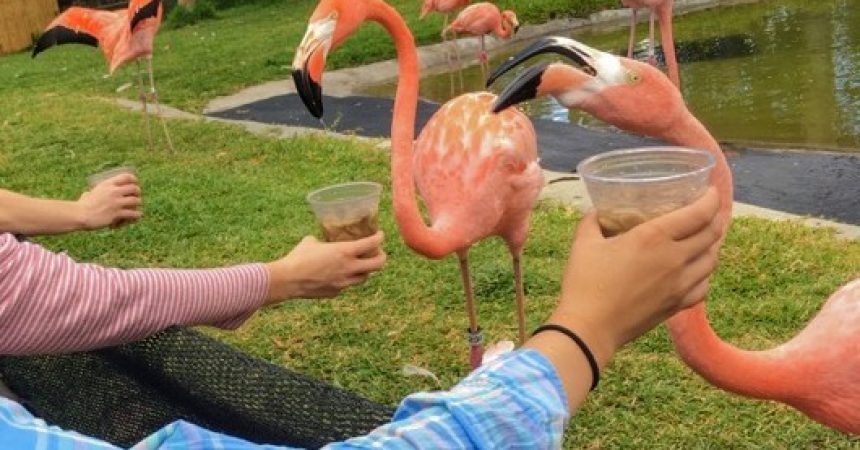Zoo InternQuest is a seven-week career exploration program for San Diego County high school juniors and seniors. Students have the opportunity to meet professionals working for the San Diego Zoo, Safari Park, and Institute for Conservation Research, learn about their jobs, and then blog about their experience online. Follow their adventures here on the Zoo’s website!
 Have you ever participated in an interactive encounter with wildlife? Did you wonder afterward how that encounter was possible? Kelly Elkins, one of the Lead Animal Trainers at the San Diego Zoo, showed us what goes on behind the scenes in these types of encounters. Ms. Elkins trains animals for the Animals in Action program, an interactive experience that aims to inspire people to do more to conserve wildlife globally. She also trains animals so that certain husbandry, or animal care, procedures are less stressful for the animals and animal care staff.
Have you ever participated in an interactive encounter with wildlife? Did you wonder afterward how that encounter was possible? Kelly Elkins, one of the Lead Animal Trainers at the San Diego Zoo, showed us what goes on behind the scenes in these types of encounters. Ms. Elkins trains animals for the Animals in Action program, an interactive experience that aims to inspire people to do more to conserve wildlife globally. She also trains animals so that certain husbandry, or animal care, procedures are less stressful for the animals and animal care staff.
Training animals comes down to motivation, which can take many forms, including receiving a favorite food or tactile reinforcements like being touched. Some animals are even motivated by the relationship between them and their trainer. Any behavior can be trained with enough time, patience, and the right motivation.
Ms. Elkins showed us how Zari, a Grant’s zebra, benefits from training. Zebras are very smart, and training gives them something to do, along with making care procedures easier and less stressful. For example, zebras can develop sharp points on their teeth caused by uneven wear when chewing. These points must be filed down in a procedure known as floating, or they can cause painful cuts in the zebra’s gums that can become infected. In order to float a zebra’s teeth, a metal file must be put in their mouth and moved around. This can be scary and stressful for the zebra, so a type of training known as desensitization is used. Desensitization is training that gets an animal used to a certain behavior, in Zari’s case, opening her mouth for the metal file used to float her teeth.
All of this training is done in such a way that the animal has choice and control over the training session, meaning they can choose whether or not they want to participate, and control when they do not want to participate anymore. For Zari, this was achieved by having a small area adjacent to her main enclosure that she can come into for the training session and leave whenever she wanted. The choice to leave means that when Zari wants to participate in training she stays in the training area. By using this training philosophy, Zari can actively participate in care procedures, making them less stressful and much easier for all involved.
Desensitization training also helps the Animal Ambassadors, animals that represent their respective species, in the Animals in Action program. Ms. Elkins introduced us to a ground cuscus, an animal that is typically shy and nocturnal. A flock of crows flew over the Animals in Action stage, which Ms. Elkins explained, would normally cause an animal like a cuscus to find the nearest place to hide. However, the cuscus she introduced had done lots of desensitization training and was not bothered. This allowed the cuscus to do her job as an Animal Ambassador, connecting people with wildlife through the interactive Animals in Action experience.
The Animals in Action experience is incredibly important to the conservation of wildlife since it is much easier for people to love something they know than something they don’t. This experience brings people and wildlife together and connects them in a way that only seeing the animals in person can. The training Ms. Elkins does with the animals not only assists in their care, but also makes this experience possible by teaching animals how to behave in situations that they would otherwise be unsure of in the wild. It is truly amazing to see how these interactive encounters, made possible by animal training, can inspire people to take action to conserve wildlife.
Kelsey, Real World Team
Week One, Fall Session 2018


